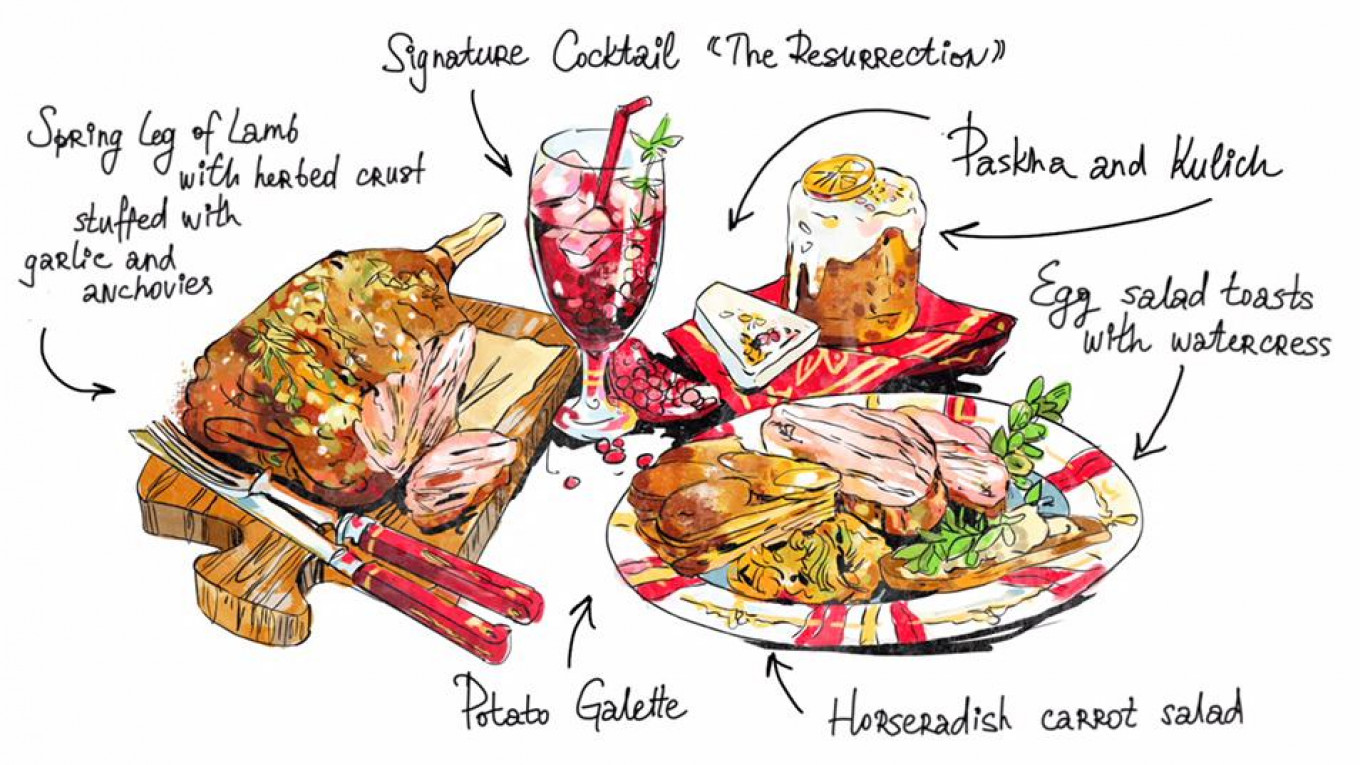“How about lamb for Easter?” I said to HRH (my Handsome Russian Husband).
“Lamb?” he said quizzically, as if I had proposed something like boa constrictor en croute.
“Lamb for Easter?” said HRH. “Not very traditional is it?”
It’s moments like these that I have to remind myself to take a few deep breaths and try to see this as humorous material.
“You’re right, of course,” I said, “apart from that thing in the liturgy about, ‘O, Lamb of God that taketh away the sins of the world…’”
“Huh?” said HRH.
“What’s traditional Easter food in your book?” I asked.
“Well, eggs,” said the pride of the Young Pioneers.
“Eggs, okay,” I said, pretending to write that down on a list and resisting the temptation to ask HRH if he had any thoughts on how to prepare the eggs.
“And Kulich, and Paskha,” HRH continued, now on a roll.
“Right,” I said.
“And maybe, pork or something?”
“That’s a great idea,” I said, “because Jesus was, of course, really into pork, which he totally would have consumed with all that cream and eggs in one sitting.”
“Huh?” said HRH.
“Jesus, you know, was more of a bitter herbs, shank bone kind of guy,” I said, but this kind of witty observation always falls on fallow ground in Russia, where they aren’t too clear on the relationship between the Old and New Testaments.
“What are you talking about?” asked HRH.
“Never mind,” I said, remembering that the tail end of that liturgical thing about lamb ends with these words: “Grant us Thy Peace."
The Easter Holy Trinity: Eggs, Paskha, and Kulich
I have mixed feelings about Orthodox Easter, primarily because I feel deeply silly having to repeat, “Verily, he is risen,” every time someone greets me with the traditional, “Christ is risen!” I once opened the door on Easter Sunday to some guys collecting a carpet to be cleaned and we had to go through all of that. I was terrified I would have to kiss each of them three times.
From a food point of view, I get extremely nervous about the hard-boiled eggs, dyed red with onion skins that go to be blessed by the priest on Thursday and don’t ever see the inside of a fridge again — that’s a food poisoning incident just waiting to happen. Then there’s the Kulich, which is a kind of cake you have to make in a tall, narrow tin, and God help you if it doesn’t rise. It doesn’t ever taste of much unless you enhance the spices, but it looks lovely iced with the traditional XB (Christ is Risen) piped on top. To compensate for the rather dry kulich is Paskha, which is a marvelous, creamy cottage cheese confection — one of my Bulgarian friends calls it “Orthodox Cheese Cake.” Paskha is molded in a trapezoidal contraption called a “pashonitsa,” one of those pieces of culinary kit that comes out only once a year. It also sports the XB logo.
These three are the essential building blocks for an Orthodox Easter meal — either a midnight supper if you are a devout churchgoer, or a breakfast if you are a lax infidel. The rigorous 40-day fast that proceeds Easter becomes especially stringent during the last week of Great Lent, but it ends promptly at 12:01 AM on Easter Sunday, when everyone races home and consumes the Holy Trinity; nothing like shocking a deprived system with a smorgasbord of dishes consisting of full fat cream, tvorog, botulism-infected hard-boiled eggs, and butter.
My approach to entertaining on Orthodox Easter is to skew things towards brunch. This gives everyone a chance to sleep in after the long service, and hopefully get the “Verily, he is risen” stuff out of their system. It also gives me a chance to un-mold my pashonitsa in peace and parlay those (refrigerated) hard-boiled eggs into something palatable.
Since Spring is taking her own sweet time about arriving this year, and Easter is nothing if not a celebration of the arrival of spring, I’m determined to propitiate the arrival of warm weather by serving up a menu chock full of springtime treats. I’ll parlay the eggs into lovely egg salad with watercress and new pea shoots, use what the Russians call “young” potatoes and fresh herbs to make an elegant galette, and serve these with a triumphant main dish of leg of spring lamb with an herbed crust. I’ll make a nod to classical myths about the return of spring in the pomegranate signature cocktail, and finish up with Paskha, which I stud with candied fruits and ginger, and a decorated Kulich to keep things traditional!
Paskha and Kulich should both be made ahead of time, especially if you would like to have them blessed in church before Easter. The lamb should marinate at least 24 hours before you cook it, but be sure to bring it to room temperature before roasting. If you can get your butcher to trim, bone, and tie the lamb, this will mean less time in the oven.
Orthodox Easter Midnight Supper (April 8)
- Signature Cocktail: “The Resurrection”
- Egg Salad Toasts with Watercress
- Spring Leg of Lamb with Herbed Crust stuffed with garlic and anchovies
- Potato Galette
- Horseradish Carrot Salad
- Paskha and Kulich
Signature Cocktail “The Resurrection”
Long before there was Jesus, there was Persephone, the daughter of Demeter. In Greek and Roman myths, Persephone is kidnapped by Hades, the God of the Underworld and taken down to Hell to reign as Hades’ queen. Demeter, the goddess of fertility pines for her child and the earth becomes cold and barren, gripped in perpetual winter. Finally, Zeus sends Hermes, the Messenger God down to Hell to negotiate Persephone’s release so that mankind will not perish. Having discovered that Persephone has eaten six pomegranate seeds, Hermes makes a deal with Hades that Persephone be allowed to spend six months of the year with her mother and six with Hades. Persephone’s return to her mother heralds the joyful return of life and spring.
Ingredients:
- 2 oz (6o ml) vodka
- 1 oz (30 ml) Domain Canton
- 1 Tbsp fresh ginger, peeled and finely minced
- 1 oz (30 ml) fresh pomegranate juice
- 1 tsp fresh pomegranate seeds
- Ginger Beer
- Candied ginger to garnish
Instructions:
- Place the vodka, Domain Canton, fresh ginger, and pomegranate juice in a cocktail shaker filled with ice and shake to combine.
- Strain into a chilled martini glass or champagne coupe.
- Add the pomegranate seeds and top off with ginger beer.Garnish with candied ginger on a cocktail stick
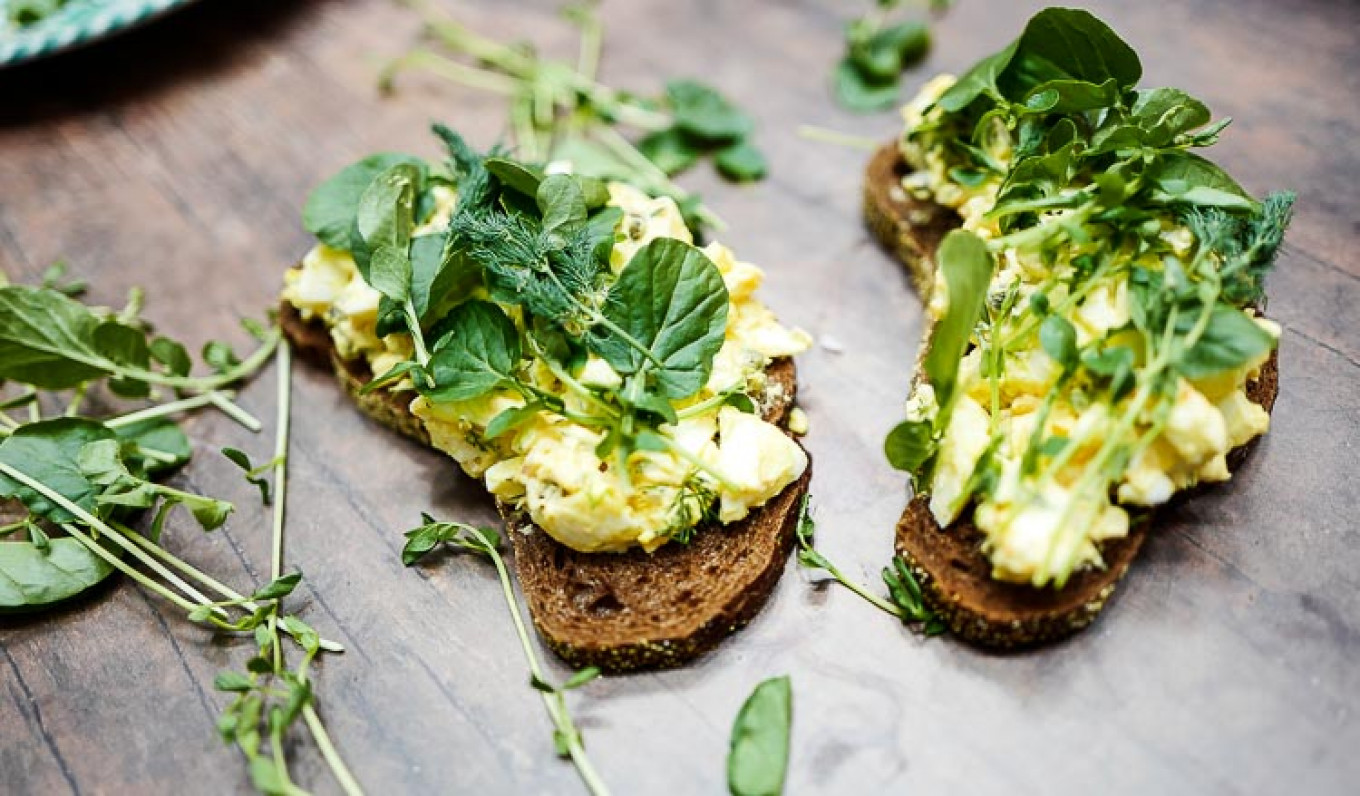
Egg Salad and Watercress Toasts
This is a great way to use up all those hard-boiled eggs!
Ingredients:
- 6 hard-boiled eggs
- 2 Tbsp best quality mayonnaise
- 1 Tbsp sour cream
- ¼-cup (60 ml) capers, chopped
- 1 medium-sized shallot, finely minced
- ¼-cup (60 ml) of cornichons, chopped
- ½-tsp of cayenne pepper
- 1 tsp of celery salt
- 1 tsp of dried mustard
- 3 Tbsp of fresh dill, chopped
- Salt and pepper to taste
- 2 cups (475 ml) of fresh watercress and/or fresh pea shoots
- 10 slices of Borodinsky Bread or any sturdy pumpernickel or rye bread
Instructions:
- Combine the hard-boiled eggs with all of the ingredients except the watercress and bread.
- Toast the bread slices on a baking sheet in an oven pre-heated to 275℉ (135℃) for 6 minutes.
- Spoon the egg salad on top of the toasted bread and top with the fresh watercress and pea shoots.
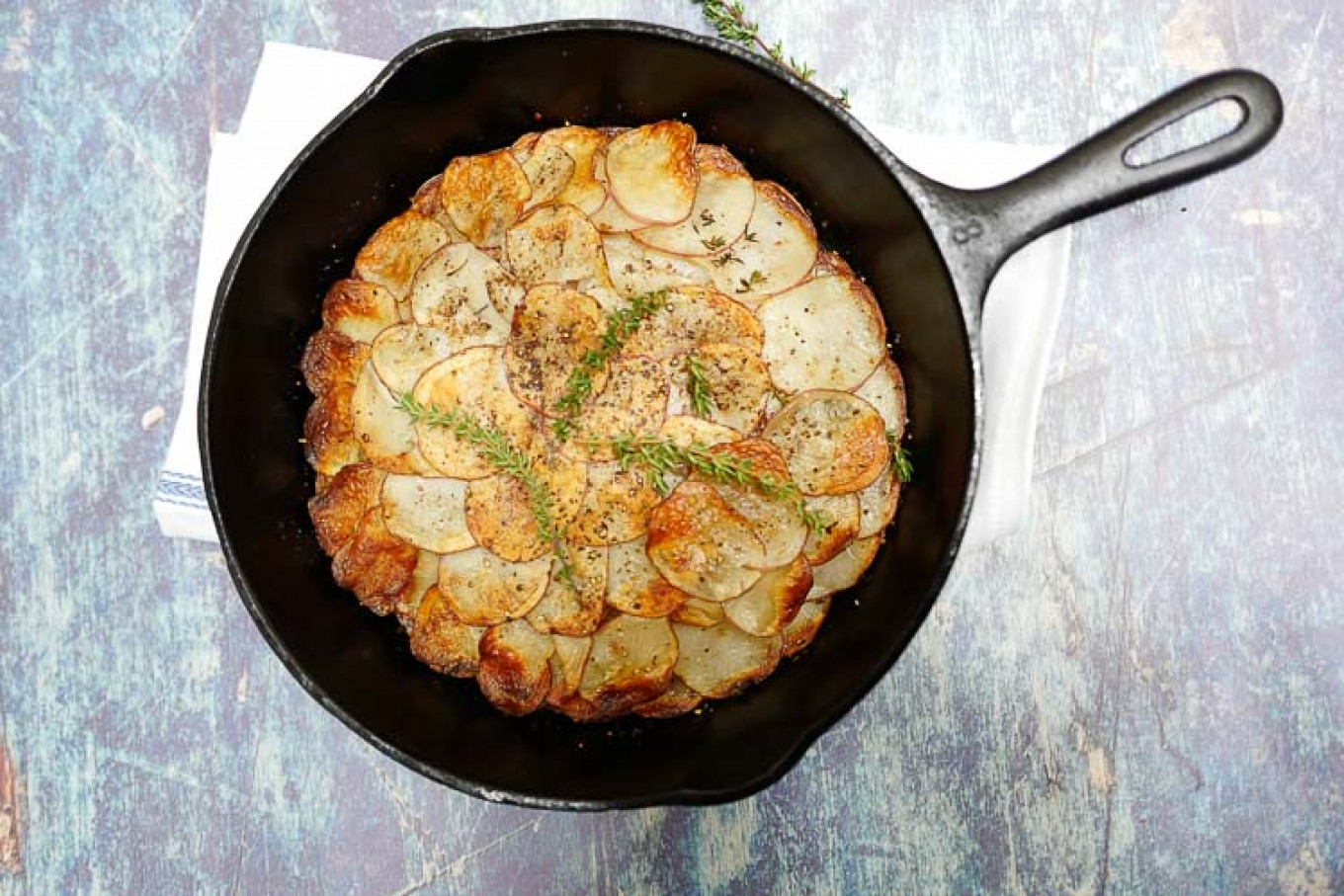
Potato Galette
This may look complicated, but trust me, it’s not. If you are nervous about the flipping part, just leave it in the skillet. I love to use duck fat on these, but clarified butter or olive oil work just as well.
Ingredients:
- 2-½ lbs. (1 kilo) red potatoes, sliced very thinly with a mandoline or food processor
- 5 sprigs fresh thyme
- ½-cup (120 ml) duck fat (or clarified butter and/or olive oil)
- sea salt and fresh ground pepper
Instructions:
- Preheat the oven to 450℉ (250℃)
- Coat the inside of an 8-inch (20 centimeters) cast iron skillet with duck fat. Place one sprig of thyme at the center of the skillet and then arrange the potato slices in an attractive spiral. (The bottom layer will be on display if you flip the galette, so be sure to use the nicest pieces.)
- Brush additional fat onto each subsequent layer, then sprinkle fresh thyme and salt and pepper.
- Make a circular cartouche of parchment paper one inch larger in diameter than the skillet.
- Brush one side with fat and place it fat side down on top of the potatoes.
- Weight the potatoes down with a heavy skillet or an ovenproof plate with a weight or brick on top of it. This will force the liquids out of the potatoes and help them bind together.
- Cook for 50 minutes, then check to see if the potatoes are done by inserting a small sharp knife through the thickness. If it goes in easily, it is done.
- Cool for 10 minutes, then use a spatula to loosen the potatoes around the perimeter of the skillet.
- Place a serving plate over the skillet, and then invert it.
- Scatter additional thyme over the galette before serving.
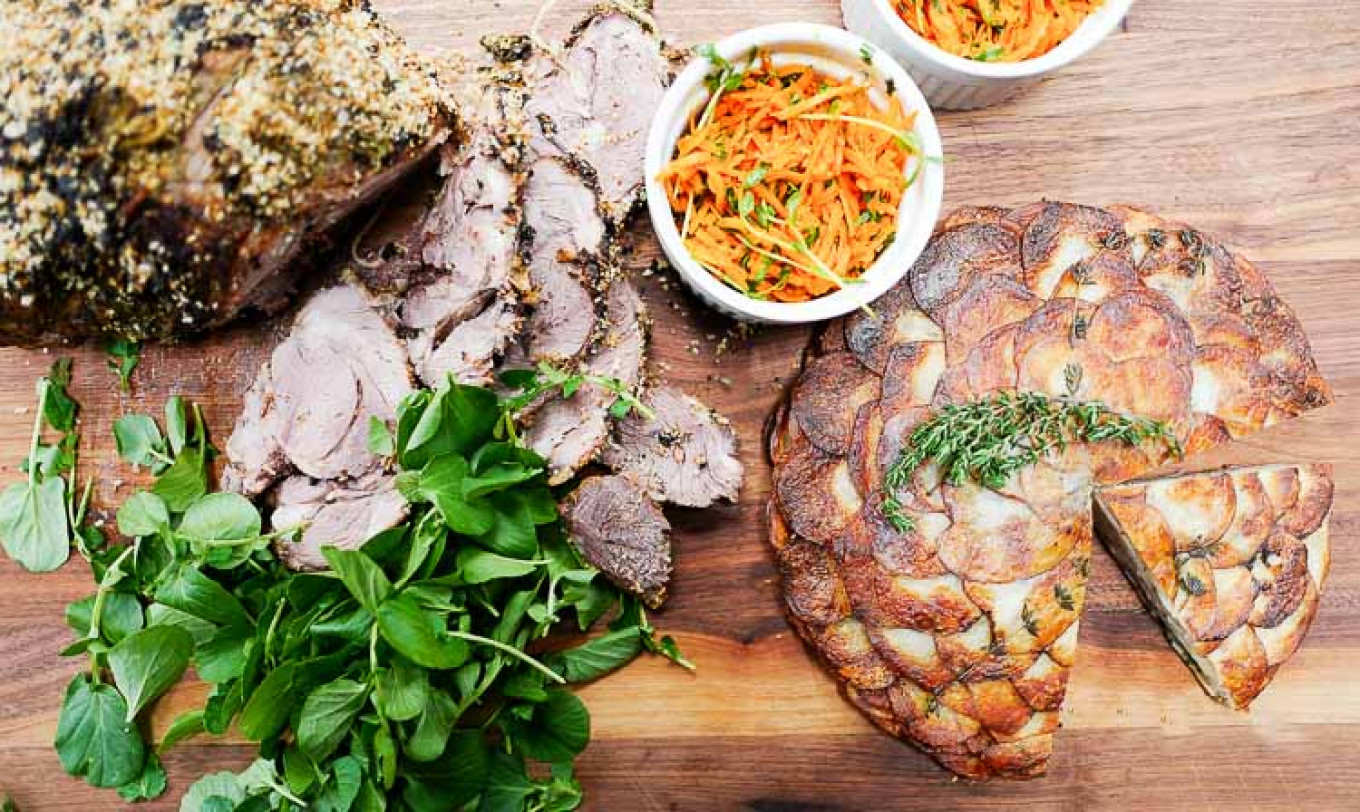
Horseradish Carrots
This recipe is an illicit love affair between that spicy Korean carrot dish, which has somehow become ubiquitous in Russia, and a more refined French version. The natural sweetness of the carrots is livened up with a dollop of prepared horseradish and Dijon mustard. Feel free to play around with adding ingredients such as pea shoots, black sesame seeds, almonds, raisins, and other vegetables.
Ingredients
- 1 lbs (500 gm) freshly picked carrots, peeled and grated
- 1 Tbsp Dijon Mustard
- 2 Tbsp fresh lemon juice
- 1 Tbsp prepared horseradish
- ⅓-cup (80ml olive oil
- 1 tsp salt
- Ground pepper to taste
- 1 cup (240 ml) fresh herbs finely chopped, such as cilantro, parsley, mint etc.
Instructions:
- Whisk together the mustard, salt, lemon juice, horseradish, and olive oil in a bowl.
- Toss the mixture with the grated carrots and set aside for 10 minutes to allow the flavors to combine.
- Toss the carrots with the fresh herbs and any other additions. Taste and adjust seasonings with additional salt and pepper.
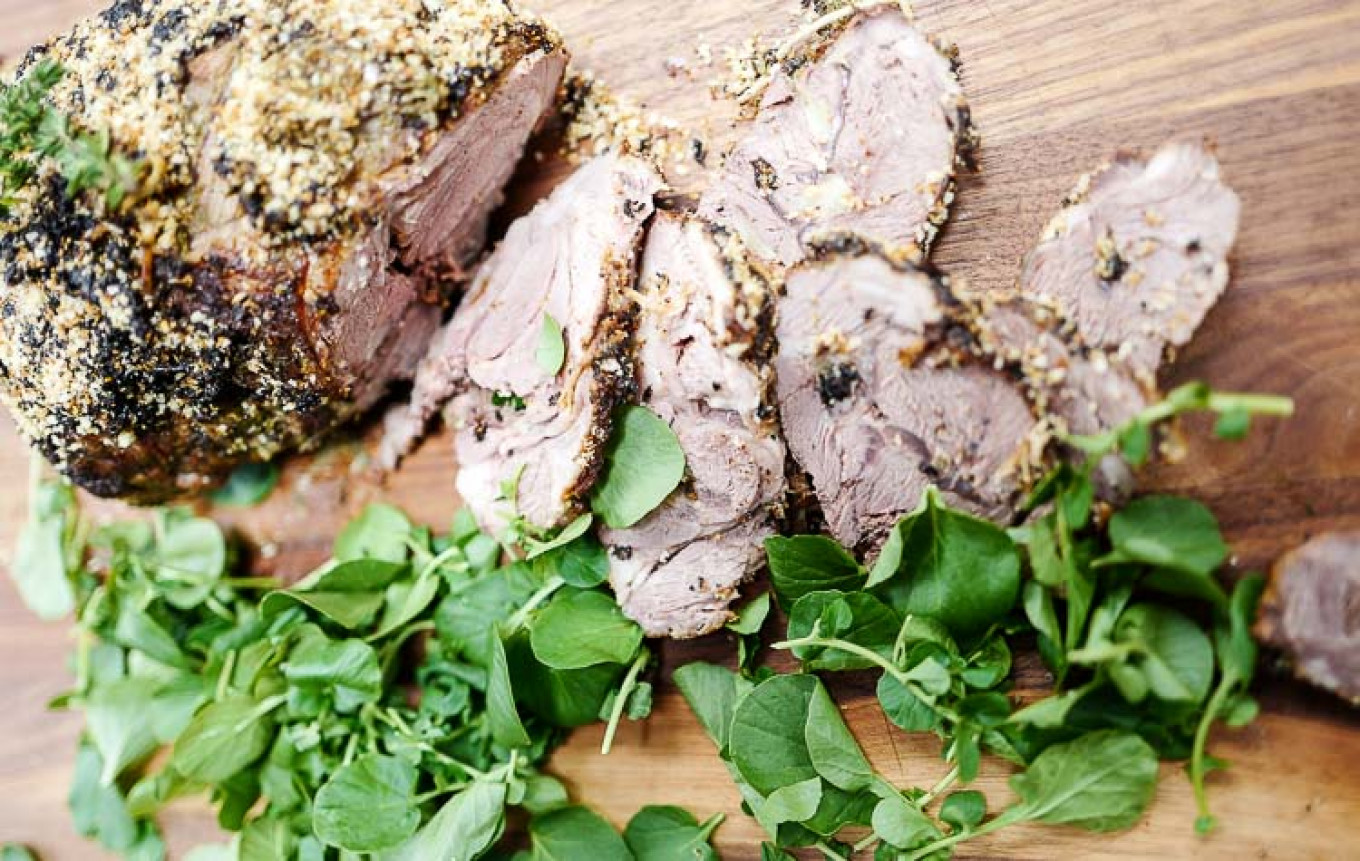
Boneless Leg of Lamb with Herbed Crust
This is my go-to recipe when I need a showstopper of a main course that can look after itself while I mix drinks and make nice with my guests. I can’t think of a time when it’s let me down and it has even replaced turkey at Thanksgiving! We love lamb in our house and this leg of lamb will make several appearances after opening night, served cold with yogurt sauce and cucumbers in lavash and if there is anything left after that, HRH gets his favorite shepherd’s pie.
This recipe must originate with Julia Child’s How to Cook, but over the years, other influences have honed, improved and refined it from Elizabeth David, Melissa Clark, and more recently the wonderful Olia Hercules, author of Mamushka and Kaukasis, who has convinced me that if some fresh herbs are good in this crust, more are even better! Enjoy!
Ingredients
- One 3-5 lb. (1.4 - 2.2 kilos) boneless leg of lamb* trimmed of all but ¼-inch of fat
- 8 cloves garlic, peeled and sliced in half
- 8 anchovy fillets
- ⅓-cup (80 ml) Dijon Mustard
- 4 Tbsp best-quality olive oil
- 1 Tbsp soy sauce
- 1-½ cups (350ml) fresh herbs such as thyme, rosemary, tarragon, mint, and parsley
- Salt and pepper
- ½-cup (118 ml) panko breadcrumbs, toasted
Instructions:
One Day Before Serving
- Spread the leg of lamb out on the counter with the bottom or non-skin side facing up. With a small paring knife, make about eight small slits at regular intervals. Slip the anchovies and garlic clove pieces into the slits.
- Tie the leg of lamb with kitchen twine. If you have not done so, use a very sharp knife to remove excess fat.
- In a food processor fitted with a steel blade, process the mustard, olive oil, soy sauce, and fresh herbs into a paste. Smear this over the top and bottom of the lamb. Cover with plastic wrap and refrigerate overnight.
On the Day of Serving
- Preheat the oven to 450°F (232°C) and adjust the oven rack to the middle position. If you have a roast function, do use it for this recipe.
- Bring the lamb to room temperature. Set it in a roasting pan and cook until an internal thermometer reads 125°F (50°C) for very rare or 140°F (60°C) for medium rare (approximately 50-60 minutes).
- Remove from the oven and tent with tin foil for 20-25 minutes to allow the juices to return to the lamb.
- Press the toasted breadcrumbs into the crust. Carve and serve.
Note:
*If you can’t get the butcher to bone the leg of lamb, not to worry, this recipe will work as well, if not better with the bone in, and you’ll have a lovely bone to play with when you are done! The only difference is how long you cook it. I follow Hugh Fearnley-Whittingstall’s advice in his authoritative The River Cottage Meat Book on larger bone-in joints: beginning at a high temperature like 450°F for an initial sizzle and then lowering the temperature to 350°F for the remainder of the cooking time.
I like my lamb rare, so my goal is to achieve an internal temperature of 125°F (50°C). If you prefer your lamb medium, then shoot for 140°F (60°C).
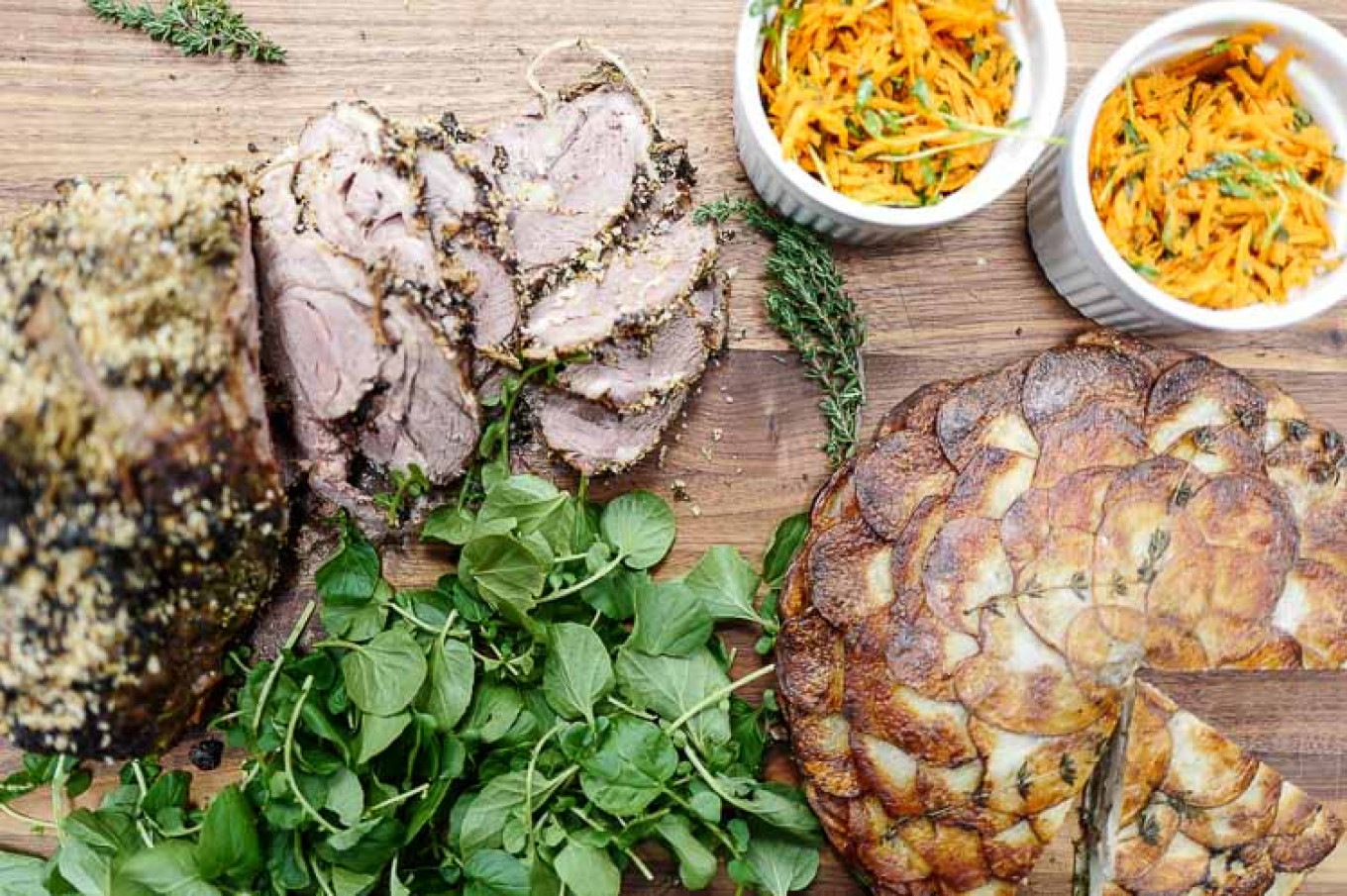
Paskha
Ingredients:
- 1-⅔ lbs (750 gm) full fat tvorog (curdcheese or farmers’ cheese)
- I lbs (500 gm) caster sugar
- 5 egg yolks
- 15 oz (450 ml) heavy whipping cream
- 16 oz (500 gm) sweet butter
- 2 cups (450 gm) chopped candied fruit, ginger, and peel
- 2 Tbsp vanilla extract
- 3 Tbsp sweet liqueur such as Cointreau or Grand Marnier
Instructions:
Note on Equipment: Paskha is traditionally molded in a trapezoidal “pasochnitsa,” which is made of either wood or plastic. Church kiosks sell them, as do the farmers markets and even amazon.com. But the lack of a pasochnitsa should not deter you: any plain mold will do, and you can decorate the un-molded dish with candied fruits.
- Whip the egg yolks together until slightly thickened. Add the sugar and beat until smooth.
- Cream the butter ina separate container and then add to the egg yolks and sugar.
- Drain the curdcheese through a fine sieve, and then mix it well into the butter, sugar and egg yolk mixture until smooth.
- Add the cream,vanilla and liqueur and mix until smooth.
- Fold in one cup of the candied fruit and peel.
- Line a mold withplastic wrap or cheesecloth. Pour the mixture into the mold, and then weight the top with a pot lid or flat plate and a heavy weight.
- Chill at least 12 hours in the refrigerator.
- Un-mold the Paskha and decorate with the remainder of the candied fruit and peel. Keep cool until serving.
Kulich
Ingredients:
- 2 packages active dry yeast (or 4-½ tsp of active dry yeast)
- 1-1/2 quarts (1-½ liter) dry flour + 1 tablespoon
- 1 tsp salt
- 1-⅓ cup (350 ml) caster sugar + 1 tablespoon
- 5 large egg yolks at room temperature
- 10 fluid oz (300 ml) whole milk, scalded and cooled to 50°C
- 8 oz (220 gm) butter, melted and cooled to 45°C
- 2 large egg whites at room temperature, whipped to stiff peaks
- 6 strands saffron dissolved in 2 tablespoons of rum
- 2 cups (475 ml) candied fruit (I use a mix of raisins,candied ginger, dried cherries, candied orange peel)
- 80 ml (1/3 cup) slivered blanched almonds
- Extra butter
- 475 ml (2 cups) icing (I used a confectioner sugar glaze)
Instructions:
Note on Equipment: Kulich cake is made in a tall, cylindrical tin. In recent years, Russian stores have sold spring-form Kulich tins, which have made life much easier. If you don’t have a kulich tin, don’t worry: you can use a clean, 1-quart juice tin lined with parchment paper.
- Butter aluminum tins, then line the bottom and sides with buttered parchment paper.
- Combine yeast, 6 Tbsp water, 1 tsp sugar and flour in a bowl. Cover and set to rise in a warm place with no breeze.
- Beat the egg yolks and sugar together until combined, then vigorously for approximately 5 minutes. When the mixture is thoroughly combined, add the milk, then flour and the salt. Knead or mix for 2 minutes.
- Add the proofed yeast, beating for 2 minutes to combine.
- Add the melted butter gradually, beating a moderate speed. Let the dough rest for two minutes, and then test for elasticity. If needed, add more flour.
- Add the egg whites and saffron and rum mixture. Once the dough is thoroughly combined, add one cup of the candied fruit.
- Cover the dough to rise in a buttered bowl placed in a warm place until it has doubled in size (2-3 hours)
- Knead the dough lightly a few times, then return it to the bowl and cover for another 2 hours.
- Divide the dough between the aluminum tins so that the dough covers slightly more than ½ of the tin. Retain 1 cup of the dough. Cover and let rise another hours.
- Preheat the oven to350°F (180°C).
- Take the retained dough and form it into strips. Place two strips across the top of the dough in each tin in the form of a cross. This will enhance the top of the kulich.
- Glaze the tops of each tin and place in the preheated oven. Cook for 15-20 minutes. Then raise the temperature to 200°C. Smaller tins will cook faster than larger ones. Kulich is finished when a skewer inserted into it comes out clean.
The final step is a little local peasant wisdom that seems to work an extra bit of magic: cover a soft bed pillow with a towel and gently place the kulich tin onto its side on the pillow. Gently roll the tin back and forth over the pillow to ease the kulich out of the buttered tin. Cool the kulich on its side on the pillow for at 40 minutes. Then place it upright and frost with the glaze of your choice. Use the remaining candied fruit and almonds to decorate the kulich in any way you wish!
Jennifer Eremeeva is a longtime expat who writes about food, travel, history and culture at http://jennifereremeeva.com. You can follow her on twitter @JWEremeeva and Instagram @jennifereremeeva.
A Message from The Moscow Times:
Dear readers,
We are facing unprecedented challenges. Russia's Prosecutor General's Office has designated The Moscow Times as an "undesirable" organization, criminalizing our work and putting our staff at risk of prosecution. This follows our earlier unjust labeling as a "foreign agent."
These actions are direct attempts to silence independent journalism in Russia. The authorities claim our work "discredits the decisions of the Russian leadership." We see things differently: we strive to provide accurate, unbiased reporting on Russia.
We, the journalists of The Moscow Times, refuse to be silenced. But to continue our work, we need your help.
Your support, no matter how small, makes a world of difference. If you can, please support us monthly starting from just $2. It's quick to set up, and every contribution makes a significant impact.
By supporting The Moscow Times, you're defending open, independent journalism in the face of repression. Thank you for standing with us.
Remind me later.



